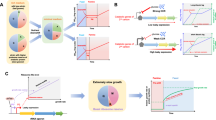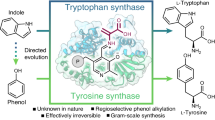Abstract
CHANGE brought about by one or a few units of cata each cell of a living organism are postulat biochemical interpretations of genetics. The nature of the changes is unknown; but a favoured suggestion is that they may consist of participation in the formation of enzymes, or their ‘shaping’ from otherwise synthesized protein molecules1. This is a theoretical conception, and no reactions denned in terms of substrates or products, and studied by biochemical techniques, have previously been recognized as due to one or a few molecules of enzyme per cell. Reasons are given below for thinking that a certain class of reactions with vitamin-like substances in bacteria may be due to such enzymes.
This is a preview of subscription content, access via your institution
Access options
Subscribe to this journal
Receive 51 print issues and online access
$199.00 per year
only $3.90 per issue
Buy this article
- Purchase on Springer Link
- Instant access to full article PDF
Prices may be subject to local taxes which are calculated during checkout
Similar content being viewed by others
References
See symposium, Ann. Missouri Bot. Garden, 32, 107 (1945), and Beadle, G. W., Chem. Rev., 37, 15 (1945).
Data (unless otherwise indicated) from Thompson, R. C., Univ. Texas Pub. No. 4237, 87 (1943), who grew the organisms at 33° in a medium containing glucose, a casein hydrolysate and inorganic salts.
1013 gm. has been taken as a typical bacterial dry weight, based on the following values (derived from data of Bergey, D. H., "Handbook of Determinative Bacteriology" (Baillière, Tindall and Cox, London); Topley, W. W. C., and Wilson, G. S., "Principles of Bacteriology and Immunity" (Arnold, London, 1946); Buchanan, R. E., and Fulmer, E. I., "Physiology and Biochemistry of Bacteria" (Baillière, Tindall and Cox, London, 1928)) for organisms of Tables 1–3: Aerobacter aerogenes, 0.4–2; Escherichia coli, 1.1–1.7; Proteus vulgaris, 0.7–1.4; Pseudomonas aeruginosa, 0.6–1.2; H"mophilus parainfluenz", 0.15–0.4; Serratia marcescens, 0.5–0.8; Streptococcus pyogenes, 0.15–0.45 × 1013 gm. The probably multinuclear nature of certain of the organisms of the tables (cf. Robinow, C. F., in Dubos, R. J. : "The Bacterial Cell" (Harvard University Press, 1945)) favours the conclusions of the present article.
McIlwain, H., Biochem. J., 40, 269 (1946).
Landy, M., Larkum, N. W., and Oswald, E. J., Proc. Soc. Exp. Biol., N.Y., 52, 338 (1943); temperature of growth, 37°.
Activity at 30°: Green, D. E., Herbert, D., and Subramanyan, V., J. Biol. Chem., 138, 327 (1941); molecular weight, Melnick, J. G., and Stern, K. G., Enzymologia, 8, 129 (1940).
Fischer, F. G., Roedig, A., and Rauch, K., Naturwiss., 27, 196 (1939).
At 37°; Negelein, E., and Brömel, H., Biochem. Z., 300, 225 (1939).
At 38°; Corran, H. S., Green, D. E., and Straub, F. B., Biochem. J., 33, 793 (1939).
At 20°, pH. 7.4; assumed molecular weight, 105: Warburg, O., and Christian, W., Biochem. Z., 303, 40 (1939).
At 20°; Negelein, E., and Wulff, H. J., Biochem. Z., 289, 436; 293, 351 (1937).
At 20°; Keilin, D., and Mann, T., Nature, 143, 23 (1939).
At 20°: Keilin, D., and Mann, T., Proc. Roy. Soc., B, 125, 187 (1938).
At 30°, pH 7.5; Berger, L., Slein, M. W., Colowick, S. P., and Cori, C. F., J. Gen. Physiol., 29, 379 (1946); Kunitz, M., and McDonald, M. R., J. Gen. Physiol., 29, 393 (1946).
At 25°; assumed molecular weight, 105; Bücher, T., quoted from the printer's proof (received privately) of a paper sent for publication in the Biochem. Z., on June 29, 1944.
At 25°; Cori, C. F., Cori, G. T., and Green, A. A., J. Biol Chem., 151, 39 (1943).
At 15°; calculated from activity and molecular weight given by Peterman, M. L., and Hakala, N. V., J. Biol. Chem., 145, 701 (1942), and the rate of the non-catalysed reaction derived from Meldrum, N. V., and Roughton, F. J. W., J. Physiol., 80, 113 (1933) and Brinkman, R., Margiara, R., and Roughton, F. J. W., Phil. Trans. Roy. Soc., A, 232, 65 (1933–34).
At 40°, taking provisional molecular weight of 670,000; Johnson, M. J., J. Biol. Chem., 137, 575 (1941).
At 0°; Keilin, D., and Hartree, E. F., Proc. Roy. Soc., B, 121, 173 (1936).
Computed, with some assumptions which are given in detail by McIlwain, H., "Advances in Enzymology", 7 (1947), from data of: Morel, M., Ann. Inst. Pasteur, 67, 285 (1941); Lwoff, A., and Lwoff M., Proc Roy. Soc., B, 1 2, 360 (1937); Lennerstrand, A., Arkiv. Kemi, Min., Geol., 14A, No. 16 (1941); Adler, E., Elliot, S., and Elliot, L., Enzymologia 8 80, (1940); Euler, H. von, and Adler, E., Hoppe Seyl. Z., 252, 41 (1938).
McIlwain, H., and Hughes, D. E., Biochem. J., 39, 133 (1945).
McIlwain, H., and Hughes, D. E., Biochem. J., 38, 187 (1944).
McIlwain, H., Biochem. J., 39, 279 (1945).
At 37°; data from Hills, G. M., Biochem. J., 37, 418 (1943); for calculation see ref. 20.
Turnover numbers for nicotinic acid derivatives during hydrogen transport by H. parainfluenz" and Pr. vulgaris can be calculated from data of Lwoff, A., and Lwoff, M., and of Morel, M. (see ref. 20), and yield values of 1 to 5 mol. H2/mol. nicotinic acid derivative/sec. Lwoff and Lwoff, however, consider experimental circumstances to render the bacterial activity artificially low.
Average from Table 1 calculated by taking the mean value for each vitamin-like substance with different organisms, and averaging these values. This gives a value of 19 mol./mol./sec. with one hour as mean generation time; if this is supposed to be 20 min., the figure becomes 57 mol./mol./sec. Average from Table 3, 65 mol./mol./sec. From Table 2, a simple average but excluding catalase and yeast polypeptidase: 560 mol./mol./sec.
Lea, D. E., "Actions of Radiations on Living Cells" (University. Press, Cambridge, 1946).
Darlington, C. D., "The Evolution of Genetic Systems" (University Press, Cambridge, 1939). Lindegren, C. C., Proc. Nat. Acad. Sci., 32, 68 (1946).
Haldane, J. B. S., "Enzymes" (Longmans, Green, London, 1930); essay in "Perspectives in Biochemistry" (University Press, Cambridge, 1937).
McIlwain, H., ref. 20. The rates are there expressed in mÎmol./mgm dry wt./hr. and the values thus differ from those of Table 3 by a factor of 3.6. Of the units available for expressing metabolic coefficients, the latter would seem preferable in being derived from the gram-mol., gram, and second, especially in calculations of the present type which involve comparison with turnover numbers already expressed with the minute or second as time-unit.
cf. Fildes, P., Proc. Roy. Soc. Med., 28, 79 (1934); Knight, B. C. J. G., Med. Res. Council Special Rep. Ser. No. 210 (1936); Lwoff, A., "L'Evolution Physiologique" (Paris, 1944).
Allinson, M. J. C., J. Biol. Chem., 147, 785 (1943).
The present considerations are relevant to only a few of the problems concerning the relative abundance of enzymes in cells. Pontecorvo (Nature, 157, 95; 1946; and private communication) suggests that in most organism, all genes produce during the life-period of a cell a few molecules only of their primary products. The primary products of the genes are then considered to be capable of self-reproduction at rates specific to them, and so to condition the turnover per cell of reactions controlled by the genes. Enzymes occurring to the extent of only a few molecules per cell may then be regarded as an extreme case derived from products with very low rates of self-reproduction. This more general scheme tends to obscure the possibility that enzymes performing mÎmol. reactions in bacteria may represent a simpler genetic process than those obtaining in other cases.
Author information
Authors and Affiliations
Rights and permissions
About this article
Cite this article
MCILWAIN, H. The Magnitude of Microbial Reactions Involving Vitamin-Like Compounds. Nature 158, 898–902 (1946). https://doi.org/10.1038/158898a0
Issue Date:
DOI: https://doi.org/10.1038/158898a0
This article is cited by
-
Lambda transducing phages derived from a finO- R100::λ cointegrate plasmid: Proteins encoded by the R100 replication/incompatibility region and the antibiotic resistance determinant
Molecular and General Genetics MGG (1979)
-
Free Radicals in Biological Materials
Nature (1954)
-
Photodynamische Auslösung von Mutationen in den Sporen von Penicillium notatum
Planta (1950)
-
Problems in microbial genetics
Heredity (1948)
Comments
By submitting a comment you agree to abide by our Terms and Community Guidelines. If you find something abusive or that does not comply with our terms or guidelines please flag it as inappropriate.



